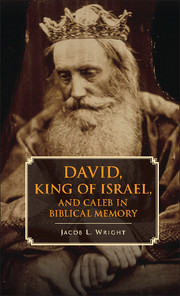Book contents
- Frontmatter
- Dedication
- Contents
- Preface
- 1 Slings and Arrows
- 2 Flesh and Stone
- 3 King of Judah
- 4 Tales of Loyalty and Betrayal
- 5 The Bones of Saul
- 6 Uriah the Hittite
- 7 Ittai the Gittite
- 8 David in Exile
- 9 Territorial Transitions
- 10 Chronicles
- 11 Caleb and the Conquest
- 12 Caleb the Warrior
- 13 Caleb the Judahite
- 14 War-Torn David
- Notes
- Index of Modern Authors
- Index of Biblical Passages and Related Texts
- Index of Historical Figures
14 - War-Torn David
Conclusions
Published online by Cambridge University Press: 05 June 2014
- Frontmatter
- Dedication
- Contents
- Preface
- 1 Slings and Arrows
- 2 Flesh and Stone
- 3 King of Judah
- 4 Tales of Loyalty and Betrayal
- 5 The Bones of Saul
- 6 Uriah the Hittite
- 7 Ittai the Gittite
- 8 David in Exile
- 9 Territorial Transitions
- 10 Chronicles
- 11 Caleb and the Conquest
- 12 Caleb the Warrior
- 13 Caleb the Judahite
- 14 War-Torn David
- Notes
- Index of Modern Authors
- Index of Biblical Passages and Related Texts
- Index of Historical Figures
Summary
For many generations, scholars have insisted that the oldest portions of the Bible are the David accounts, especially the so-called Court History or Succession Narrative (2 Sam 9–20 and 1 Kings 1–2). Likewise, some still assert that earliest sources of the Pentateuch were composed in the direct wake of these writings.
The present investigation has severely undermined these claims. I have demonstrated that the Court History likely developed in several stages, and that even its oldest portions are probably late addenda to the earliest account of David’s life.
That account, which I have called the History of David’s Reign (HDR), has nothing to say about Israel. Instead, it presents David as the youngest of eight sons. Without prospects of a patrimony, he takes the career path of many disadvantaged, making a name for himself as a soldier of fortune and warlord. In the employ of a Philistine potentate, he wins the allegiance of clans in the southern hill country. Eventually these clans come together to anoint him king over “the House of Judah.”
David builds his capital at Hebron, located at the center his kingdom and already an important site a thousand years before his reign. Early supplements to this account tell how David captures Jerusalem (the City of David). It serves as a fortress on the northern periphery of the kingdom, in the territory of Benjamin, where Judahite kings later competed with northern states (see, e.g., 1 Kings 15:16–22), and where even the historical David may have staked a claim.
This early account of David’s reign relates solely to Judah and has nothing to say (explicitly) about Israel. The Court History, however, depicts various kinds of challenges David faces as ruler of Israel. It therefore cannot be as old as often thought. Rather, its authors presuppose a series of thorough revisions and substantial expansions that tell how David came to occupy the throne of Israel.
Information
- Type
- Chapter
- Information
- David, King of Israel, and Caleb in Biblical Memory , pp. 221 - 230Publisher: Cambridge University PressPrint publication year: 2014
